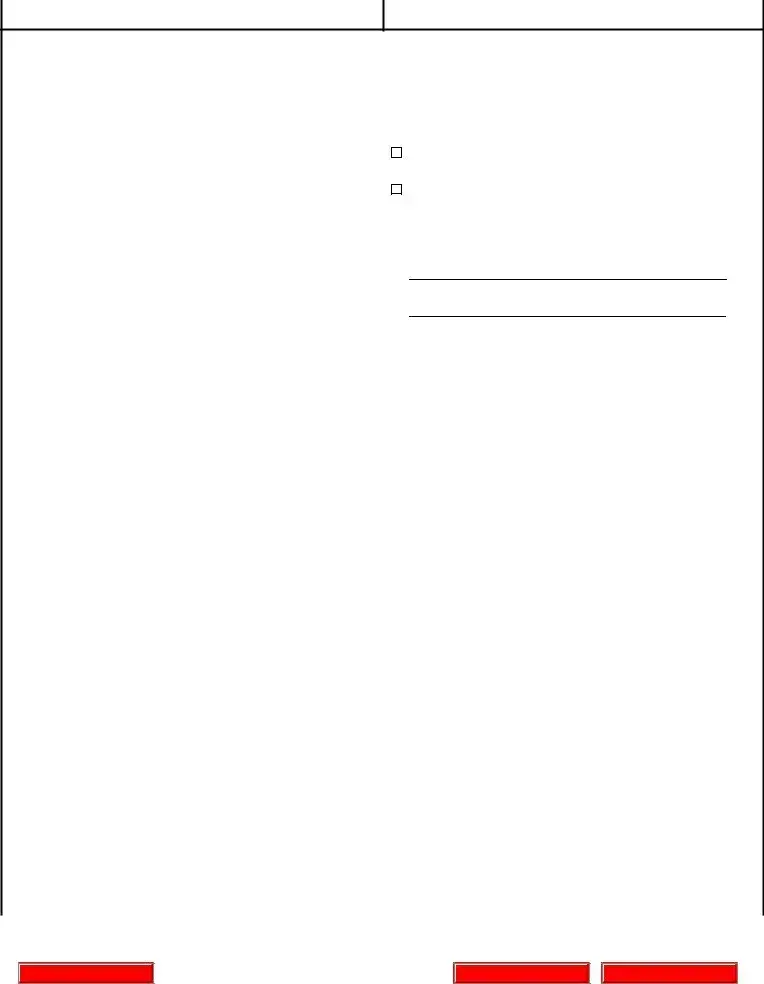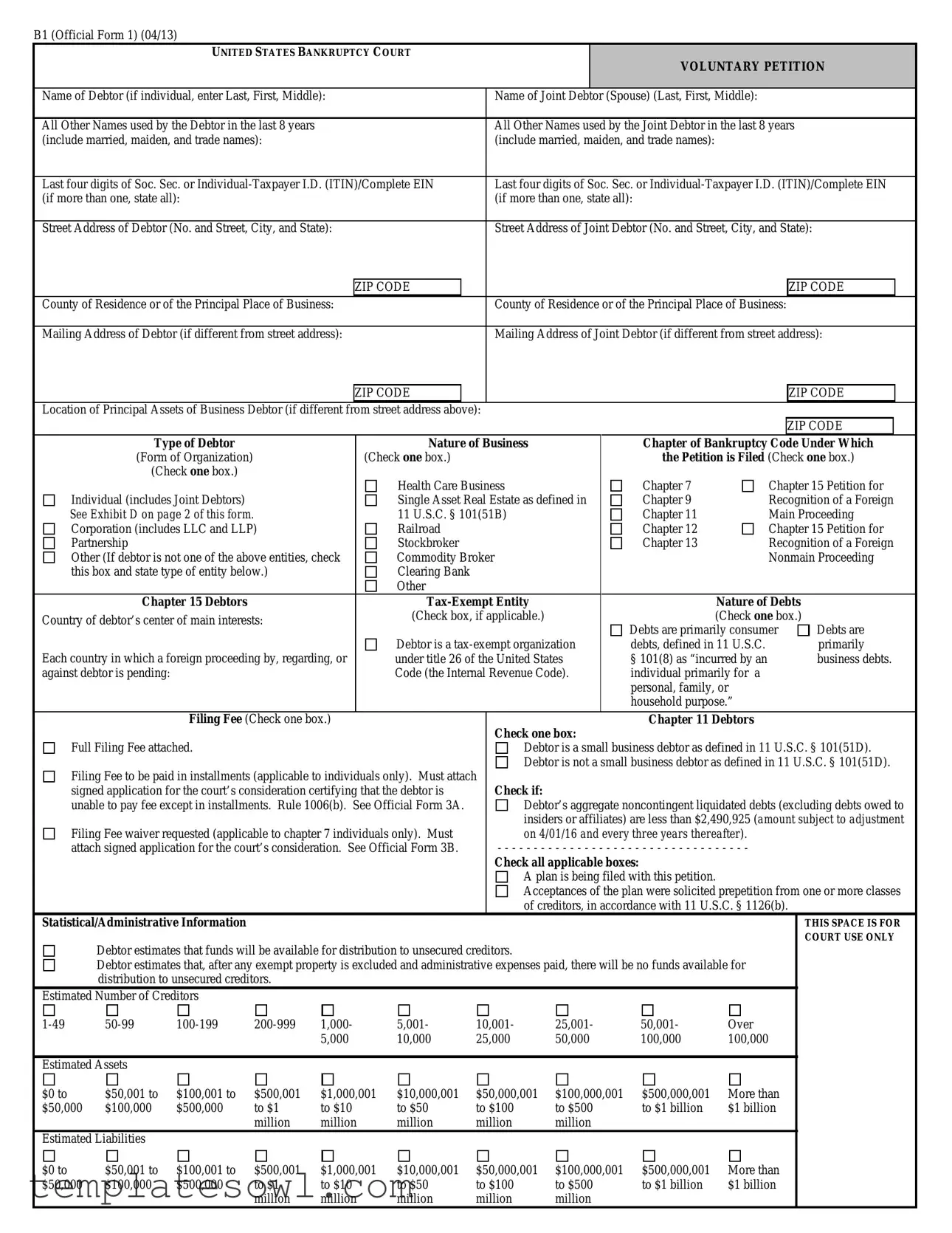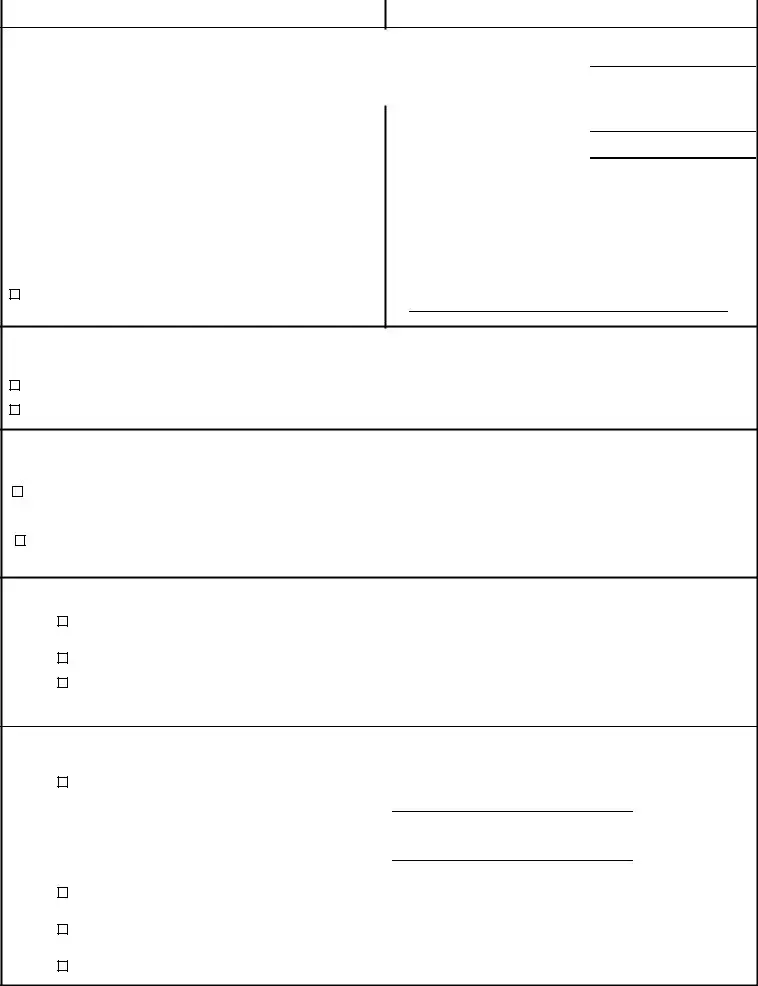B1 (Official Form 1) (04/13)
|
|
UNITED STATES BANKRUPTCY COURT |
|
|
|
|
|
VOLUNTARY PETITION |
|
|
__________ District of __________ |
|
|
|
|
|
|
|
|
|
|
|
|
|
|
|
|
|
|
|
|
|
|
|
|
|
|
|
|
|
|
|
|
|
Name of Debtor (if individual, enter Last, First, Middle): |
|
|
|
Name of Joint Debtor (Spouse) (Last, First, Middle): |
|
|
|
|
|
|
|
|
|
|
|
|
|
|
|
|
|
All Other Names used by the Debtor in the last 8 years |
|
|
|
|
|
|
All Other Names used by the Joint Debtor in the last 8 years |
|
|
|
(include married, maiden, and trade names): |
|
|
|
|
|
|
(include married, maiden, and trade names): |
|
|
|
|
|
|
|
|
|
|
|
|
|
|
|
|
|
Last four digits of Soc. Sec. or Individual-Taxpayer I.D. (ITIN)/Complete EIN |
|
Last four digits of Soc. Sec. or Individual-Taxpayer I.D. (ITIN)/Complete EIN |
(if more than one, state all): |
|
|
|
|
|
|
|
(if more than one, state all): |
|
|
|
|
|
|
|
|
|
|
|
|
|
|
|
|
Street Address of Debtor (No. and Street, City, and State): |
|
|
|
Street Address of Joint Debtor (No. and Street, City, and State): |
|
|
|
|
|
|
|
|
|
|
|
|
|
|
|
|
|
|
|
|
|
|
|
|
ZIP CODE |
|
|
|
|
|
|
|
|
ZIP CODE |
|
County of Residence or of the Principal Place of Business: |
|
|
|
|
|
County of Residence or of the Principal Place of Business: |
|
|
|
|
|
|
|
|
|
|
|
|
|
|
|
Mailing Address of Debtor (if different from street address): |
|
|
|
Mailing Address of Joint Debtor (if different from street address): |
|
|
|
|
|
|
|
|
|
|
|
|
|
|
|
|
|
|
|
|
|
|
ZIP CODE |
|
|
|
|
|
|
|
|
ZIP CODE |
|
Location of Principal Assets of Business Debtor (if different from street address above): |
|
|
|
|
|
|
|
|
|
|
|
|
|
|
|
|
|
|
|
|
|
|
|
|
|
|
ZIP CODE |
|
|
Type of Debtor |
|
|
|
|
Nature of Business |
|
|
|
Chapter of Bankruptcy Code Under Which |
|
(Form of Organization) |
|
|
|
(Check one box.) |
|
|
|
|
|
the Petition is Filed (Check one box.) |
|
(Check one box.) |
|
|
|
|
Health Care Business |
|
|
|
Chapter 7 |
Chapter 15 Petition for |
|
|
|
|
|
|
|
|
|
|
Individual (includes Joint Debtors) |
|
|
|
|
Single Asset Real Estate as defined in |
|
Chapter 9 |
Recognition of a Foreign |
See Exhibit D on page 2 of this form. |
|
|
|
|
11 U.S.C. § 101(51B) |
|
|
|
Chapter 11 |
Main Proceeding |
Corporation (includes LLC and LLP) |
|
|
|
Railroad |
|
|
|
|
|
Chapter 12 |
Chapter 15 Petition for |
Partnership |
|
|
|
|
|
Stockbroker |
|
|
|
|
|
Chapter 13 |
Recognition of a Foreign |
Other (If debtor is not one of the above entities, check |
|
Commodity Broker |
|
|
|
|
Nonmain Proceeding |
this box and state type of entity below.) |
|
|
|
Clearing Bank |
|
|
|
|
|
|
|
|
|
|
|
|
|
|
|
|
|
|
|
Other |
|
|
|
|
|
|
|
|
|
|
|
|
|
Chapter 15 Debtors |
|
|
|
|
Tax-Exempt Entity |
|
|
|
|
Nature of Debts |
|
|
|
Country of debtor’s center of main interests: |
|
|
|
(Check box, if applicable.) |
|
|
|
|
(Check one box.) |
|
|
|
|
|
|
|
|
|
|
|
|
|
Debts are primarily consumer |
Debts are |
|
|
|
|
|
|
|
Debtor is a tax-exempt organization |
|
Each country in which a foreign proceeding by, regarding, or |
|
|
debts, defined in 11 U.S.C. |
primarily |
|
under title 26 of the United States |
|
§ 101(8) as “incurred by an |
business debts. |
against debtor is pending: |
|
|
|
|
|
Code (the Internal Revenue Code). |
|
individual primarily for a |
|
|
|
|
|
|
|
|
|
|
|
|
|
|
|
|
|
personal, family, or |
|
|
|
|
|
|
|
|
|
|
|
|
|
|
|
|
|
household purpose.” |
|
|
|
|
|
Filing Fee (Check one box.) |
|
|
|
|
Check one box: |
Chapter 11 Debtors |
|
|
|
|
|
|
|
|
|
|
|
|
|
|
|
|
|
|
|
|
Full Filing Fee attached. |
|
|
|
|
|
|
|
Debtor is a small business debtor as defined in 11 U.S.C. § 101(51D). |
Filing Fee to be paid in installments (applicable to individuals only). Must attach |
Debtor is not a small business debtor as defined in 11 U.S.C. § 101(51D). |
Check if: |
|
|
|
|
|
|
|
|
|
|
signed application for the court’s consideration certifying that the debtor is |
|
|
|
|
|
|
|
|
|
|
|
unable to pay fee except in installments. Rule 1006(b). See Official Form 3A. |
|
Debtor’s aggregate noncontingent liquidated debts (excluding debts owed to |
|
|
|
|
|
|
|
|
|
|
insiders or affiliates) are less than $2,490,925 (amount subject to adjustment |
Filing Fee waiver requested (applicable to chapter 7 individuals only). Must |
|
on 4/01/16 and every three years thereafter). |
|
|
|
attach signed application for the court’s consideration. See Official Form 3B. |
|
- - - - - - - - - - - - - - - - - - - - - - - - - - - - - - - - - - - |
|
|
|
|
|
|
|
|
|
|
|
|
|
|
|
Check all applicable boxes: |
|
|
|
|
|
|
|
|
|
|
|
|
|
|
|
|
A plan is being filed with this petition. |
|
|
|
|
|
|
|
|
|
|
|
|
|
Acceptances of the plan were solicited prepetition from one or more classes |
|
|
|
|
|
|
|
|
|
|
of creditors, in accordance with 11 U.S.C. § 1126(b). |
|
|
|
Statistical/Administrative Information |
|
|
|
|
|
|
|
|
|
|
|
|
|
|
|
THIS SPACE IS FOR |
|
Debtor estimates that funds will be available for distribution to unsecured creditors. |
|
|
|
|
|
|
|
COURT USE ONLY |
|
|
|
|
|
|
|
|
|
|
|
|
Debtor estimates that, after any exempt property is excluded and administrative expenses paid, there will be no funds available for |
|
|
|
|
|
distribution to unsecured creditors. |
|
|
|
|
|
|
|
|
|
|
|
|
|
|
|
|
|
Estimated Number of Creditors |
|
|
|
|
|
|
|
|
|
|
|
|
|
|
|
|
|
|
1-49 |
50-99 |
100-199 |
200-999 |
1,000- |
|
|
5,001- |
|
10,001- |
25,001- |
|
50,001- |
Over |
|
|
|
|
|
|
|
|
5,000 |
|
|
10,000 |
|
25,000 |
50,000 |
|
|
100,000 |
100,000 |
|
|
|
|
|
|
|
|
|
|
|
|
|
|
|
|
|
|
|
|
|
|
|
|
|
Estimated Assets |
|
|
|
|
|
|
|
|
|
|
|
|
|
|
|
|
|
|
|
$0 to |
$50,001 to |
$100,001 to |
$500,001 |
$1,000,001 |
$10,000,001 |
|
$50,000,001 |
$100,000,001 |
$500,000,001 |
More than |
|
|
|
|
$50,000 |
$100,000 |
$500,000 |
to $1 |
to $10 |
to $50 |
to $100 |
to $500 |
to $1 billion |
$1 billion |
|
|
|
|
|
|
|
million |
million |
million |
million |
million |
|
|
|
|
|
|
|
Estimated Liabilities |
|
|
|
|
|
|
|
|
|
|
|
|
|
|
|
|
|
|
|
$0 to |
$50,001 to |
$100,001 to |
$500,001 |
$1,000,001 |
$10,000,001 |
|
$50,000,001 |
$100,000,001 |
$500,000,001 |
More than |
|
|
|
|
$50,000 |
$100,000 |
$500,000 |
to $1 |
to $10 |
to $50 |
to $100 |
to $500 |
to $1 billion |
$1 billion |
|
|
|
|
|
|
|
million |
million |
million |
million |
million |
|
|
|
|
|
|
|
B1 (Official Form 1) (04/13) |
Page 2 |
Voluntary Petition |
Name of Debtor(s): |
(This page must be completed and filed in every case.) |
|
All Prior Bankruptcy Cases Filed Within Last 8 Years (If more than two, attach additional sheet.)
Location |
|
Case Number: |
Date Filed: |
Where Filed: |
|
|
Date Filed: |
Location |
|
Case Number: |
Where Filed: |
|
|
|
|
Pending Bankruptcy Case Filed by any Spouse, Partner, or Affiliate of this Debtor (If more than one, attach additional sheet.) |
Name of Debtor: |
|
Case Number: |
Date Filed: |
|
|
|
Judge: |
District: |
|
Relationship: |
|
|
|
|
Exhibit A |
Exhibit B |
(To be completed if debtor is required to file periodic reports (e.g., forms 10K and |
(To be completed if debtor is an individual |
10Q) with the Securities and Exchange Commission pursuant to Section 13 or 15(d) |
whose debts are primarily consumer debts.) |
of the Securities Exchange Act of 1934 and is requesting relief under chapter 11.) |
I, the attorney for the petitioner named in the foregoing petition, declare that I have |
|
|
informed the petitioner that [he or she] may proceed under chapter 7, 11, 12, or 13 |
|
of title 11, United States Code, and have explained the relief available under each |
|
such chapter. I further certify that I have delivered to the debtor the notice required |
Exhibit A is attached and made a part of this petition. |
by 11 U.S.C. § 342(b). |
|
X |
|
|
|
|
Signature of Attorney for Debtor(s) |
(Date) |
Exhibit C
Does the debtor own or have possession of any property that poses or is alleged to pose a threat of imminent and identifiable harm to public health or safety?
Yes, and Exhibit C is attached and made a part of this petition.
No.
Exhibit D
(To be completed by every individual debtor. If a joint petition is filed, each spouse must complete and attach a separate Exhibit D.)
Exhibit D, completed and signed by the debtor, is attached and made a part of this petition.
If this is a joint petition:
Exhibit D, also completed and signed by the joint debtor, is attached and made a part of this petition.
Information Regarding the Debtor - Venue
(Check any applicable box.)
Debtor has been domiciled or has had a residence, principal place of business, or principal assets in this District for 180 days immediately preceding the date of this petition or for a longer part of such 180 days than in any other District.
There is a bankruptcy case concerning debtor’s affiliate, general partner, or partnership pending in this District.
Debtor is a debtor in a foreign proceeding and has its principal place of business or principal assets in the United States in this District, or has no principal place of business or assets in the United States but is a defendant in an action or proceeding [in a federal or state court] in this District, or the interests of the parties will be served in regard to the relief sought in this District.
Certification by a Debtor Who Resides as a Tenant of Residential Property
(Check all applicable boxes.)
Landlord has a judgment against the debtor for possession of debtor’s residence. (If box checked, complete the following.)
(Name of landlord that obtained judgment)
(Address of landlord)
Debtor claims that under applicable nonbankruptcy law, there are circumstances under which the debtor would be permitted to cure the entire monetary default that gave rise to the judgment for possession, after the judgment for possession was entered, and
Debtor has included with this petition the deposit with the court of any rent that would become due during the 30-day period after the filing of the petition.
Debtor certifies that he/she has served the Landlord with this certification. (11 U.S.C. § 362(l)).

B1 (Official Form 1) (04/13) |
Page 3 |
Voluntary Petition |
Name of Debtor(s): |
(This page must be completed and filed in every case.)
Signatures
|
Signature(s) of Debtor(s) (Individual/Joint) |
|
Signature of a Foreign Representative |
I declare under penalty of perjury that the information provided in this petition is true |
I declare under penalty of perjury that the information provided in this petition is true |
and correct. |
and correct, that I am the foreign representative of a debtor in a foreign proceeding, |
[If petitioner is an individual whose debts are primarily consumer debts and has |
and that I am authorized to file this petition. |
chosen to file under chapter 7] I am aware that I may proceed under chapter 7, 11, 12 |
(Check only one box.) |
|
|
or 13 of title 11, United States Code, understand the relief available under each such |
|
|
|
|
|
|
chapter, and choose to proceed under chapter 7. |
|
I request relief in accordance with chapter 15 of title 11, United States Code. |
[If no attorney represents me and no bankruptcy petition preparer signs the petition] I |
|
|
Certified copies of the documents required by 11 U.S.C. § 1515 are attached. |
have obtained and read the notice required by 11 U.S.C. § 342(b). |
|
|
|
|
|
I request relief in accordance with the chapter of title 11, United States Code, |
|
Pursuant to 11 U.S.C. § 1511, I request relief in accordance with the |
chapter of title 11 specified in this petition. A certified copy of the |
specified in this petition. |
|
order granting recognition of the foreign main proceeding is attached. |
X |
|
|
X |
|
|
|
Signature of Debtor |
|
(Signature of Foreign Representative) |
|
|
X |
|
|
|
|
|
|
|
Signature of Joint Debtor |
|
(Printed Name of Foreign Representative) |
|
|
|
|
|
|
|
|
|
Telephone Number (if not represented by attorney) |
|
Date |
|
|
|
|
|
|
|
|
|
|
Date |
|
|
|
|
|
|
Signature of Attorney* |
|
Signature of Non-Attorney Bankruptcy Petition Preparer |
X |
|
|
I declare under penalty of perjury that: |
(1) I am a bankruptcy petition preparer as |
|
Signature of Attorney for Debtor(s) |
defined in 11 U.S.C. § 110; (2) I prepared this document for compensation and have |
|
|
|
|
provided the debtor with a copy of this document and the notices and information |
|
Printed Name of Attorney for Debtor(s) |
required under 11 U.S.C. §§ 110(b), 110(h), and 342(b); and, (3) if rules or |
|
|
|
|
guidelines have been promulgated pursuant to 11 U.S.C. § 110(h) setting a maximum |
|
Firm Name |
fee for services chargeable by bankruptcy petition preparers, I have given the debtor |
|
|
|
|
notice of the maximum amount before preparing any document for filing for a debtor |
|
|
|
|
or accepting any fee from the debtor, as required in that section. Official Form 19 is |
|
|
|
|
attached. |
|
|
|
Address |
|
|
|
|
|
|
|
|
|
|
|
Telephone Number |
|
Printed Name and title, if any, of Bankruptcy Petition Preparer |
|
|
|
|
|
|
|
|
Date |
|
|
|
|
*In a case in which § 707(b)(4)(D) applies, this signature also constitutes a |
|
Social-Security number (If the bankruptcy petition preparer is not an individual, |
|
state the Social-Security number of the officer, principal, responsible person or |
certification that the attorney has no knowledge after an inquiry that the information |
|
partner of the bankruptcy petition preparer.) (Required by 11 U.S.C. § 110.) |
in the schedules is incorrect. |
|
|
|
|
|
|
|
|
|
|
|
Signature of Debtor (Corporation/Partnership) |
|
|
|
|
I declare under penalty of perjury that the information provided in this petition is true |
|
|
|
|
|
Address |
|
|
and correct, and that I have been authorized to file this petition on behalf of the |
|
|
|
|
debtor. |
X |
|
|
The debtor requests the relief in accordance with the chapter of title 11, United States |
|
|
|
Signature |
|
|
Code, specified in this petition. |
|
|
|
|
X |
|
|
|
|
|
Date |
|
|
|
Signature of Authorized Individual |
|
|
|
|
|
|
|
|
|
Signature of bankruptcy petition preparer or officer, principal, responsible person, or |
|
Printed Name of Authorized Individual |
|
partner whose Social-Security number is provided above. |
|
|
|
|
|
|
|
|
Title of Authorized Individual |
Names and Social-Security numbers of all other individuals who prepared or assisted |
|
|
|
|
|
|
|
|
in preparing this document unless the |
bankruptcy petition preparer is not an |
|
Date |
|
individual. |
|
|
|
|
|
|
|
|
|
|
|
|
If more than one person prepared this document, attach additional sheets conforming |
|
|
|
|
to the appropriate official form for each person. |
|
|
|
|
A bankruptcy petition preparer’s failure to comply with the provisions of title 11 and |
|
|
|
|
the Federal Rules of Bankruptcy Procedure may result in fines or imprisonment or |
|
|
|
|
both. 11 U.S.C. § 110; 18 U.S.C. § 156. |
|
|



